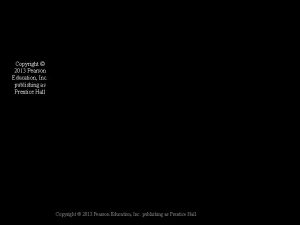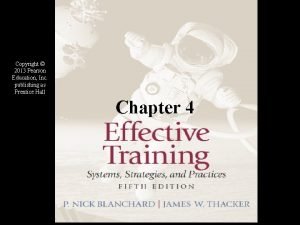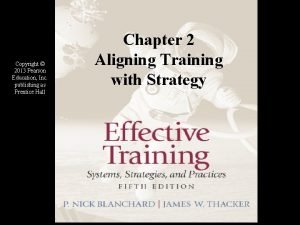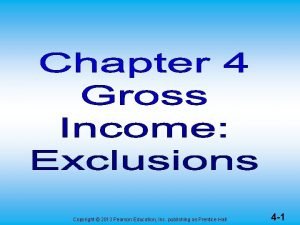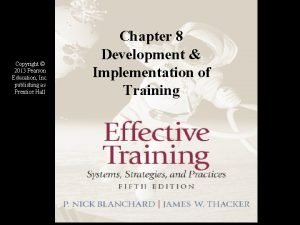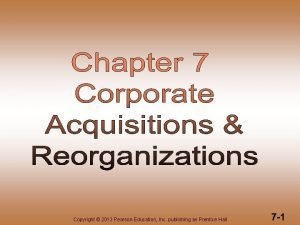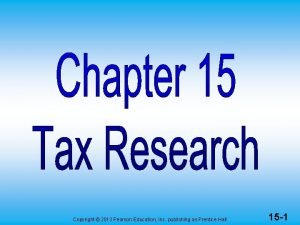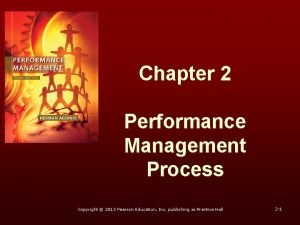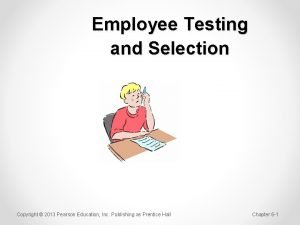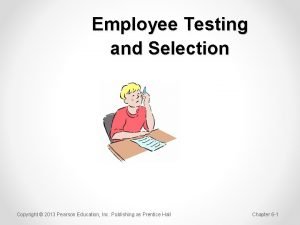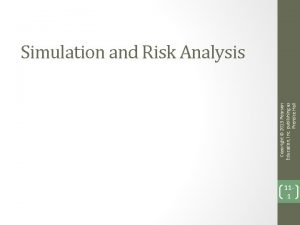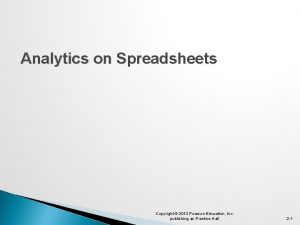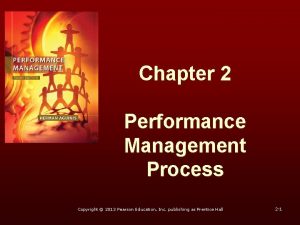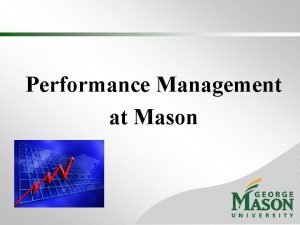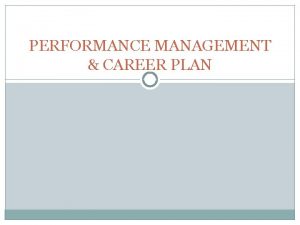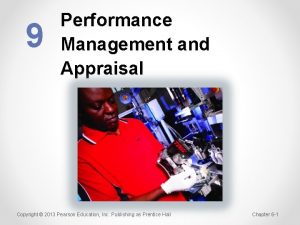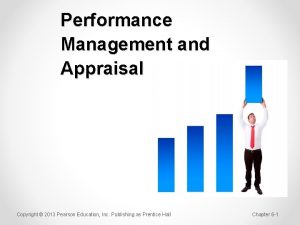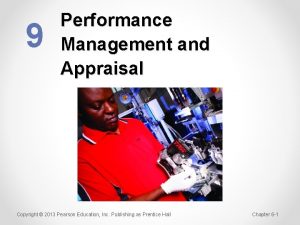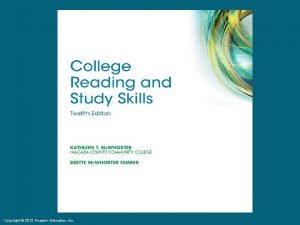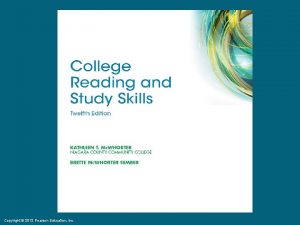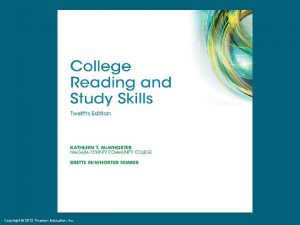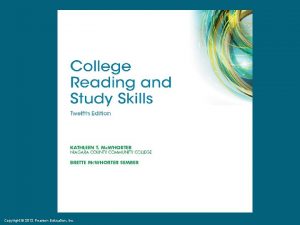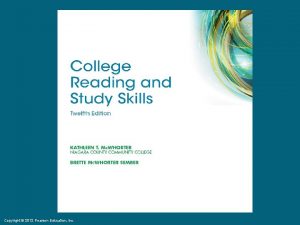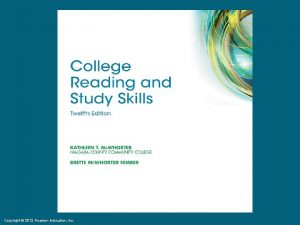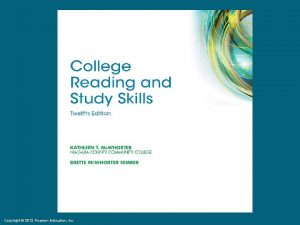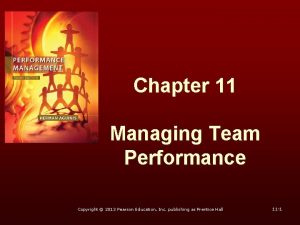Chapter 2 Performance Management Process Copyright 2013 Pearson































- Slides: 31

Chapter 2 Performance Management Process Copyright © 2013 Pearson Education, Inc. publishing as Prentice Hall 2 -1

Prerequisite s Performance Planning Performance Management Process Performance Renewal and Recontractin g Performance Review Performance Execution Performance Assessment Copyright © 2013 Pearson Education, Inc. publishing as Prentice Hall 2 -2

Prerequisites A. B. Knowledge of the organization’s mission and strategic goals Knowledge of the job in question Copyright © 2013 Pearson Education, Inc. publishing as Prentice Hall 2 -3

Knowledge of Mission and Strategic Goals n Strategic planning • Purpose or reason for the organization’s existence • Where the organization is going • Organizational goals • Strategies for attaining goals Copyright © 2013 Pearson Education, Inc. publishing as Prentice Hall 2 -4

Knowledge of Mission and Strategic Goals An important objective of any performance management system is to enhance each employee’s contribution to the goals of the organization. If there is a lack of clarity regarding where the organization wants to go, or if the relationship between the organization’s mission and strategies and the unit’s mission and strategies is not clear, there will be a lack of clarity regarding what each employee needs to do and achieve to help the organization get there. Copyright © 2013 Pearson Education, Inc. publishing as Prentice Hall 5

Mission and Goals § Cascade effect throughout organization • Organization Unit Employee Once the goals for the entire organization have been established, similar goals cascade downward, with departments setting objectives to support the organization’s overall mission and objectives. The cascading continues downward until each employee has a set of goals compatible with those of the organization. Copyright © 2013 Pearson Education, Inc. publishing as Prentice Hall 2 -6

Knowledge of the Job The second prerequisite before a PM system is implemented is to understand each particular job. This is done through job analysis – the process of determining the key components of a particular job, including: • Activities • Tasks • Products • Services • Processes Copyright © 2013 Pearson Education, Inc. publishing as Prentice Hall 2 -7

Knowledge of the Job (Continued) • Knowledge (K) • Skills (S) • Abilities (A) KSAs The tasks and KSAs needed for a particular job are typically presented in the form of a job description, which summarizes the job duties, required KSAs, and working conditions for a particular job. Copyright © 2013 Pearson Education, Inc. publishing as Prentice Hall 2 -8

Generic Job Descriptions Generic job descriptions can be obtained from the Occupational Informational Network (O*Net) http: //online. onetcenter. org/ The descriptions available on O*Net can serve as a foundation for a job description. They can easily be adapted and changed to accommodate specific jobs. Copyright © 2013 Pearson Education, Inc. publishing as Prentice Hall 2 -9

Job Analysis Job analysis can be conducted using: • Interviews (job analyst may ask the interviewee to describe what s/he does during a typical day at the job from start to finish) • Observation • Questionnaires (available on the Internet – include a common list of tasks or KSAs, and ask individuals to indicate the extent to which each task or KSA is required for a particular job) Copyright © 2013 Pearson Education, Inc. publishing as Prentice Hall 2 -10

Job Analysis Follow-Up n All incumbents should: • Review information • Provide feedback • Rate tasks and KSAs in terms of Frequency n Criticality n Copyright © 2013 Pearson Education, Inc. publishing as Prentice Hall 2 -11

Frequency and Criticality Rating both frequency and criticality is necessary because some tasks may be performed regularly (e. g. , making coffee several times a day) but may not be very critical. The job analyst can then multiply the frequency scores by the criticality scores to obtain an overall score for each task. So if coffee making receives a frequency score of 4 (made 4 times a day) and a criticality score of 0 (not critical), the overall score would be 4 x 0 = 0. Copyright © 2013 Pearson Education, Inc. publishing as Prentice Hall 12

Rater Biases Rating of frequency and criticality of tasks and KSAs is susceptible to: • Self-serving bias • Social projection bias • False consensus bias Taken together, these biases affect job analysis ratings because they lead people to believe that their own KSAs are those driving success on their jobs. This leads to an exaggerated view of the importance of these KSAs. Copyright © 2013 Pearson Education, Inc. publishing as Prentice Hall 2 -13

Rater Training Web-based training: Structure • Takes only about 15 minutes • Establishes common point of reference via largely 5 steps n In the 5 steps, participants basically practice their rating skills • As a result, reduces exaggeration of the importance of certain task and KSAs Copyright © 2013 Pearson Education, Inc. publishing as Prentice Hall 2 -14

Rater Training (Continued) Web-based training: 5 steps 1. Defines the rating dimensions 2. Defines the scale anchors 3. Describes behaviors indicative of each rating dimension 4. Allows raters to practice their rating skills, and 5. Provides feedback on the practice Copyright © 2013 Pearson Education, Inc. publishing as Prentice Hall 2 -15

Performance Planning: Results üKey accountabilities üSpecific objectives üPerformance standards Copyright © 2013 Pearson Education, Inc. publishing as Prentice Hall 2 -16

Key Accountabilities Broad areas of a job for which n the employee is responsible for producing results n Copyright © 2013 Pearson Education, Inc. publishing as Prentice Hall 2 -17

Specific Objectives n Statements of outcomes • Important • Measurable Copyright © 2013 Pearson Education, Inc. publishing as Prentice Hall 2 -18

Performance Standards n n “Yardstick” to evaluate how well employees have achieved each objective Information on acceptable and unacceptable performance, such as • Quality • Quantity • Cost • Time Copyright © 2013 Pearson Education, Inc. publishing as Prentice Hall 2 -19

Performance Planning: Behaviors Ø How a job is done Copyright © 2013 Pearson Education, Inc. publishing as Prentice Hall 2 -20

Performance Planning: Competencies n n Measurable clusters of KSAs Critical in determining how results will be achieved Copyright © 2013 Pearson Education, Inc. publishing as Prentice Hall 2 -21

Performance Planning: Development Plan § Areas for improvement § Goals to be achieved in each area of improvement Copyright © 2013 Pearson Education, Inc. publishing as Prentice Hall 2 -22

Performance Execution: Employee’s Responsibilities § Commitment to goal achievement § Ongoing requests for feedback and § § § coaching Communication with supervisor Collecting and sharing performance data Preparing for performance reviews Copyright © 2013 Pearson Education, Inc. publishing as Prentice Hall 2 -23

Performance Execution: Manager’s Responsibilities n n n Observation and documentation Updates Feedback Resources Reinforcement Copyright © 2013 Pearson Education, Inc. publishing as Prentice Hall 2 -24

Performance Assessment n n n Manager assessment Self-assessment Other sources (e. g. , peers, customers) Copyright © 2013 Pearson Education, Inc. publishing as Prentice Hall 2 -25

Multiple Assessments Are Necessary To… Ø Ø Increase employee ownership Increase commitment Provide information Ensure mutual understanding Copyright © 2013 Pearson Education, Inc. publishing as Prentice Hall 2 -26

Performance Review Overview of Appraisal Meeting n Past • Behaviors and results n Present • Compensation to be received n Future • New goals and development plans Copyright © 2013 Pearson Education, Inc. publishing as Prentice Hall 2 -27

Six Steps for Conducting Productive Performance Reviews 1. 2. 3. Identify what the employee has done well and poorly Solicit feedback Discuss the implications of changing behaviors Copyright © 2013 Pearson Education, Inc. publishing as Prentice Hall 2 -28

Six Steps for Conducting Productive Performance Reviews 4. 5. 6. Explain how skills used in past achievements can help overcome any performance problems Agree on an action plan Set a follow-up meeting and agree on behaviors, actions, and attitudes to be evaluated Copyright © 2013 Pearson Education, Inc. publishing as Prentice Hall 2 -29

Performance Renewal and Recontracting n Identical to performance planning EXCEPT: • Uses insights and information from previous phases • Restarts the performance management cycle Copyright © 2013 Pearson Education, Inc. publishing as Prentice Hall 2 -30

Performance Management Process Summary: Key Points ü ü Ongoing process Each component is important v. If one is implemented poorly, the whole system suffers ü Links between components must be clear Copyright © 2013 Pearson Education, Inc. publishing as Prentice Hall 2 -31
 Mbti personal impact report
Mbti personal impact report 2013 pearson education inc
2013 pearson education inc 2013 pearson education inc
2013 pearson education inc Performance gap
Performance gap 2013 pearson education inc
2013 pearson education inc 2013 pearson education inc
2013 pearson education inc 2013 pearson education inc
2013 pearson education inc 2013 pearson education inc
2013 pearson education inc 2013 pearson education inc
2013 pearson education inc 2013 pearson education inc
2013 pearson education inc Are clusters of measurable ksas
Are clusters of measurable ksas 2013 pearson education inc. answers
2013 pearson education inc. answers Employee testing and selection
Employee testing and selection 2013 pearson education inc
2013 pearson education inc 2013 pearson education inc
2013 pearson education inc 2017 pearson education ltd
2017 pearson education ltd 2017 pearson education inc
2017 pearson education inc Copyright 2010 pearson education inc
Copyright 2010 pearson education inc Copyright 2009
Copyright 2009 2018 pearson education inc
2018 pearson education inc 2014 pearson education inc
2014 pearson education inc Copyright 2010 pearson education inc
Copyright 2010 pearson education inc Copyright 2010 pearson education inc
Copyright 2010 pearson education inc Copyright by pearson education inc. answers
Copyright by pearson education inc. answers 2008 pearson education inc
2008 pearson education inc Copyright 2005 pearson prentice hall inc
Copyright 2005 pearson prentice hall inc Copyright 2009 pearson education inc
Copyright 2009 pearson education inc 2015 pearson education inc
2015 pearson education inc Copyright 2010 pearson education inc
Copyright 2010 pearson education inc Copyright 2010 pearson education inc
Copyright 2010 pearson education inc Copyright 2010 pearson education inc
Copyright 2010 pearson education inc Copyright 2010 pearson education inc
Copyright 2010 pearson education inc


